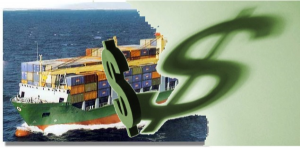How Did Carriers Go From Looking at Billions in Losses to Billions in Profit in 2020?
 Ocean freight carriers are supposed to lose billions of dollars in 2020, right? Wrong. They’re going to make billions. Probably. As long as things continue the way they’re going. Wait. What?
Ocean freight carriers are supposed to lose billions of dollars in 2020, right? Wrong. They’re going to make billions. Probably. As long as things continue the way they’re going. Wait. What?
There’s an old saying: never trust projections during a pandemic or an election year. Okay, that’s not a saying, but it should be. In fact, I’m laying claim to it right now. Don’t forget to credit me when you share the quote. Has the world changed so much in the last handful of weeks that international shipping headlines should be flashing projections that completely contradict the headline projections we’ve been seeing the last few months? Probably not, but it’s clear those earlier projections were way off. Right?
Changing Projections
No one ever knows if projections will pan out. It seems much more common that they don’t than they do. I’d like to say that I hope you’re not basing your life on projections, but all of us are right now. We’ve shut down economies across the globe based on worst-case pandemic infection, death, and death rate projections, some of which we know were wrong and some of which we’ll never be able to know how accurate it was. As economies reopen, people are fighting over whether we’ve gone too far or haven’t gone far enough, and the threat of re-closures looms.
While doctors and academics were presenting conflicting models about how many people would die due to COVID-19, experts in the international shipping industry were making predictions like ocean freight carriers would lose between $800 million and $23 billion in 2020.
Yeah, that’s not a wide range at all.
Despite how broad these projected losses were, they were apparently still completely wrong, as, halfway through the year, the same experts are now projecting carriers to rake in a profit of over $9 billion in 2020. Both the old projection and the new one come from maritime data and analysis company Sea-Intelligence and are being widely reported.
Bucking Projections
There’s nothing new about projections not coming true or being changed. However, the original projection itself may have helped it to not come true. Seeing such devastating numbers as $23 billion in losses may have helped motivated ocean carriers to take the aggressive action they have so far during this pandemic.
Perhaps it isn’t a simple case of the previous projections being wrong. Perhaps it’s more a matter of carriers strategizing to make sure the previous projections don’t come to pass. Carriers have done big things this year to make 2020 profitable.
In actuality, the biggest things carriers have done to make freight rates high and generate a profit may be three things they haven’t done.
1. Blank Sailings
You could call cancelling doing something, but, ultimately, it’s the action of not doing something. By not sailing ships, carriers have dramatically decreased capacity in 2020 and put tremendous upward pressure on freight rates. There are hundreds of sailings in 2020 that have been blanked.
We’ve obviously been talking about blank sailings a great deal this year. All of the following blog articles and more get into 2020 blank sailing:
Coronavirus & IMO 2020 Good News, Bad News
Coronavirus Effect on Ports Update
Big Roundup of Coronavirus Pandemic’s Effect on Ocean Freight Shipping
Blank Sailings Help Maersk Profit Despite COVID-19 — Will Blank Sailings Continue?
Carriers Unveil Q3 Blank Sailings & What it Means
Avoiding Freight Wars
This is an area where carriers have gotten into serious trouble in the past. Often, ocean carriers struggle to maintain high or even moderately healthy freight rates because they begin undercutting each other to try to take a larger cut of the market. So far in 2020, carriers have done an excellent job of not engaging in any trade wars that would cause freight rates drop when economic shutdowns already endanger the shipping companies with falls in demand.
Of course, we still have half the year left for carriers to revert to their old ways. If they do, freight rates could fall dramatically and projections could revert back to the shipping companies suffering losses instead of making profits.
Not Dropping Rates To Match Oil Price Drops
IMO 2020 was supposed to shoot oil and fuel prices way up for carriers, which they would pass on to shippers. In fact, carriers were preemptively passing these costs on to shippers in the latter parts of 2019. However, IMO 2020 quickly got overshadowed by the coronavirus pandemic and the oil market crashed. It crashed hard.
Plummeting oil prices often means a drop in freight rates. Despite oil dropping into the negatives for the first time in history, freight rates didn’t really drop with oil. Freight rates actually remained strong. Very strong. There were low sulfur fuel surcharges dropped during 2020, but shippers have not seen the kind of savings they could normally expect from such events in the oil market.
2020 Freight Rates
Carriers have been quite impressive in how successfully they kept freight rates up through this pandemic year despite incredible reductions in demand. It’s especially impressive when considering how often they’ve failed to keep freight rates up when demand has increased during many years in the past.
Using the Shanghai Containerized Freight Index (SCFI), Mike Wackett reports in the Loadstar that Asia-US west coast spot rates were up last week 93% from the same week a year prior. For Asia-Europe, there’s a less massive but still very respectable year-on-year increase of 30%.
That may sound like more bad news to shippers; however, there still is an angle that these higher freight rates can be viewed from. If carriers really did end up seeing $23 billion losses in 2020, we might end up with another Hanjin collapse situation, and shrinking competition is bad for shippers in terms of both freight rates and service in the long run.




